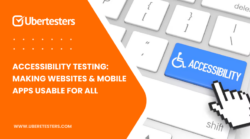Customer-Centric Testing: QA Centered on User Feedback

Caring about your customers' opinions on how easy it is to use a product or service is a major recipe for a long-lasting business. That is why successful organizations are putting more resources into developing products with the consumer in mind than ever before. In particular, user feedback assists with identifying usability issues, and it is part of the customer-centric testing process.
According to LinkedIn, customer-centric testing is a method that puts the client first at every stage of testing, making sure the end result satisfies both technical requirements and user expectations. By adopting this strategy, companies can ensure that every new feature and functionality is based on a genuine customer need. Making features and goods with the consumer in mind isn't as simple as pressing a button, though. So, what is the customer-centric meaning ? How can testing professionals adapt to the approach of customer-centric development?
The Shift Toward Customer-Centric Testing

As per the Consortium for Information and Software Quality the yearly cost of inadequate software quality to US business entities exceeds $2.08 trillion. Thus, the shift toward customer-centric testing is necessary.
Historical QA approach: routines that focus on technical aspects
Traditional QA (Quality Assurance) methods have long centered on the tech aspects of software development. Experts would use such approaches for detecting and eliminating bugs. This is a nice way to make sure that the piece of software functions as it should. Techniques such as manual testing, unit testing, and integration testing have been the backbone of QA, aiming to detect flaws in code and technical errors before release. This approach prioritizes the technical functionality of the product, ensuring that it meets the set specifications and works reliably in various environments and under different conditions. However, these traditional methods often emphasize reactive rather than proactive quality improvement, focusing more on fixing issues rather than preventing them through user-centric or process-driven strategies.
The rise of customer-centric models: how the focus shifted from internal testing to customer-driven QA
When it comes to sustainable development models, a customer-centric business model has become an essential component. This is the type of model that places equal importance on retaining existing customers, advocating for the company, and expanding into new markets. With more competition than ever before, soaring expenses per acquisition, and an increased demand for long-term, sustainable growth, organizations that have chosen a model that is centered on the customer are more likely to experience growth and success. Over time, the approach to Quality Assurance has evolved from internal testing that primarily focused on tech nuances to a more customer-driven model. Traditionally, the goal of testing specialists was to ensure that the software meets internal specifications. Features and performance, along with tech aspects, were in the first place. However, as user experience became a critical factor, QA began to shift toward a user-centered product testing approach. Customer-driven QA places greater emphasis on understanding real-world user needs and behaviors. It involves gathering feedback from users, incorporating usability testing, and prioritizing customer satisfaction alongside technical accuracy. This shift acknowledges that a product may function correctly from a technical standpoint but still fail to meet customer expectations if it’s not intuitive or relevant to their needs. By integrating customer feedback early, companies can deliver products that not only work well but also provide a seamless user experience.
Key Components of Customer-Centric Testing

To understand the importance of integrating UX user testing and interaction check in QA services, let’s consider the key components of customer-centric audit.
- User involvement. Actively engaging real users throughout the testing process ensures that the product aligns with their needs and expectations. Their feedback helps identify usability issues that might be overlooked in technical examination.
- Real-world testing environments. Specialists can perform testing in real-world settings to replicate actual usage scenarios. To identify potential customer experience issues, simulate a variety of user conditions, network conditions, and device configurations.
- Iterative feedback loops. It’s very important to include testing all the way through the development process, from A to Z. Usability problems can be found and fixed during early tests. This iterative method cuts down on rework and makes sure that the product keeps changing and improving based on what users say.
- Cross-functional collaboration. QA teams work closely with developers, designers, and product managers to integrate user feedback into the development process. This collaboration fosters a holistic approach to quality that balances technical functionality with user experience.
- Usability testing. Prioritize usability examination to assess the ease with which users may achieve their objectives with the product. Recognize usability challenges early in the development process and tweak the design to improve usability.
Benefits of Customer-Centric Testing
Client-centric examination is known for having multiple advantages for testers, other team members, and users.
Improved product quality
Design that is centered on the client becomes an important distinction in a market saturated with competitors who offer products and services that are comparable to one another. By making the desires of their clients a top priority, businesses can come up with unique value propositions to stand out from their rivals. In its turn, this leads to enhanced product quality, expanding the customer base, and establishing a solid reputation for the brand.
Higher user satisfaction
A customer-centric approach boosts client satisfaction, which can help you succeed in today's competitive company market. Businesses that prioritize customer-centric design study their consumers' wants, preferences, and pain concerns. A company may make customers feel valued and understood by personalizing their offers to their target demographic. Additionally, customer-centric design allows for customized interactions. Businesses can give clients a sense of exclusivity and unique treatment by tailoring solutions. This personalized approach creates an emotional connection between the customer and the brand, increasing satisfaction and loyalty.
Reduced time-to-market
By involving users early and incorporating feedback throughout development, potential issues are caught and addressed faster. This streamlines the testing process, minimizing delays and enabling quicker product launches.
Lower long-term costs
Client-centric software testing helps prevent major usability and functionality issues post-launch. It is possible to dramatically save expenses associated with post-release fixes by locating and fixing problems with the user experience at an earlier stage in the development cycle.
Best Practices for Implementing Customer-Centric QA

Implementing flexible QA solutions and user-focused tests requires attention to what customers say and several other hints.
Incorporating user feedback early and often
User feedback can be integrated into development in numerous ways. Setting up a feedback loop where users may offer their opinions through the product or a dedicated feedback portal is widespread. In real-time user testing, potential customers utilize the product and provide feedback.
- Set a feedback loop
- Run user tests
- Review and prioritize feedback regularly
Developers may learn, enhance customer satisfaction, and create a more successful product by incorporating feedback.
Prioritizing feedback
Prioritize user comments that will most affect your product. This includes assessing feedback frequency and user experience. Developers can prioritize comments to fix the most significant issues and maximize resource usage.
- Consider feedback frequency
- Evaluation of affected users
- Assess user experience impact
Cross-departmental communication
Foster collaboration between development, QA, product management, and customer support teams to ensure that customer needs are fully integrated into the QA process. In addition, involve external testers and beta testers throughout the development process. This helps to detect potential issues at the early stage and address them before release.
Transparency with users
Keep users informed and involved through regular feedback loops, beta testing, and clear communication. This openness builds trust, ensures the product aligns with user expectations and allows for continuous improvement based on real user experiences.
Challenges in Implementing Customer-Centric Testing
Despite all the advantages, some issues may seem a challenge to those who are involved in user-centric checks.
Limited access to diverse user groups
Reaching a wide and varied pool of users for testing can be difficult, especially when trying to ensure the product works well across different demographics, devices, and use cases. This limitation can lead to gaps in understanding user needs.
Time and resource constraints
Customer-centric testing often requires more time and resources compared to traditional testing methods. Incorporating user feedback into the development cycle can slow down the process, particularly if there are multiple iterations required to address the issues identified.
Difficulty in replicating real-world environments
Simulating real-world conditions and how users interact with the product in everyday settings can be challenging. Factors like network conditions, device variations, and user behavior are difficult to replicate fully in controlled testing environments.
Managing and analyzing large volumes of feedback
To be customer-centric, it's important to use tracking and product analytics tools to learn more about your customers. As you plan your test, think about these things to overcome this challenge:
- Think about the different browsers and gadgets your customers will be using. Add the range to your plans for tests.
- What OS and settings do your customers use?
- Push for customer feedback through polls, reviews, scores, etc.
- Review your flow data often. Are there patterns in certain software pages or screens?
- Learn about how well the system is working. Tools for tracking production can help you figure out where customers are having performance problems.
Benefits of Crowd Testing for Customer-Centric Testing

Multiple options exist for emphasizing customer-centric testing. For instance, software companies may leverage crowdtesting and internal testing teams for user-centric features. The best method is to combine crowdtesting with functional testing services to create a user-focused app. Traditional functional testing uses regression, integration, smoke, and functional testing to find issues. In its turn, crowdtesting finds bugs the development team misses, including production and localized bugs. The benefits of this approach include:
- Diverse real-world feedback
- Increased coverage
- Faster issue identification and overall turnaround time
- Global reach
- Scalability and flexibility
- Unbiased testing
- Cost-effectiveness
Through the utilization of crowdsourcing, businesses are able to create test clients from a vast pool of resources without having to employ their own internal resources.
Conclusion
Customer-centric testing that focuses on user feedback offers significant benefits by aligning product development with real user needs and expectations. By actively involving users in the testing process, companies can identify usability issues early, leading to a more refined, user-friendly product. This approach not only enhances user satisfaction but also reduces costly post-launch fixes, accelerates time-to-market, and fosters stronger customer loyalty. The quickest and least expensive method to guarantee thorough user-centric testing —and, ultimately, to build an app that makes consumers happy—is to use crowdtesting. It provides real-world insights at scale, ensuring a better user experience. Future development can be better planned with the support of crowdsourced comments, which is another great benefit of crowdtesting. Getting it right the first time is crucial to digital success; remember that a customer's first impressions of an app could also be their last impressions. Thus, why won’t you embrace crowd-testing for improved product quality and user satisfaction, combining it with the customer-centric examination? Looking to dive deeper into the benefits of crowd-testing? Reach out to us at sales@ubertesters.com for an in-depth exploration.

